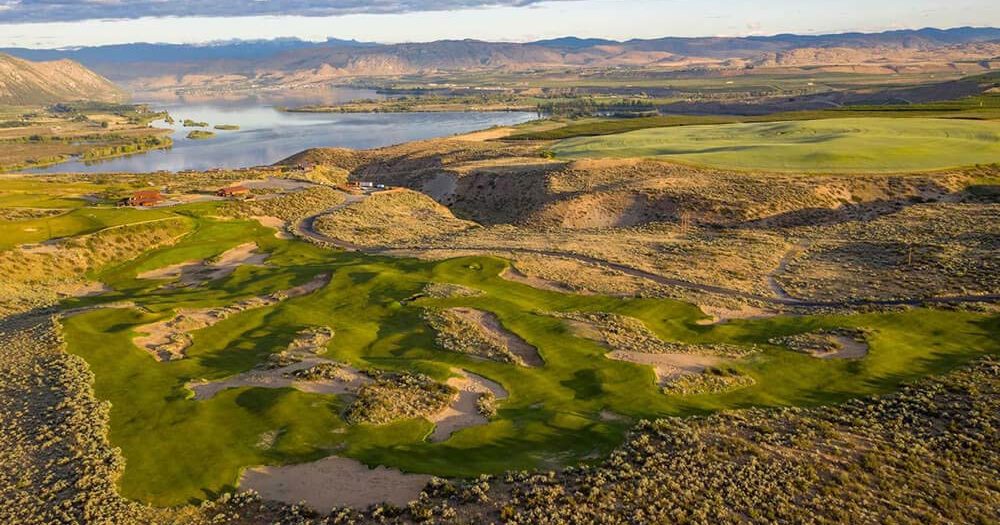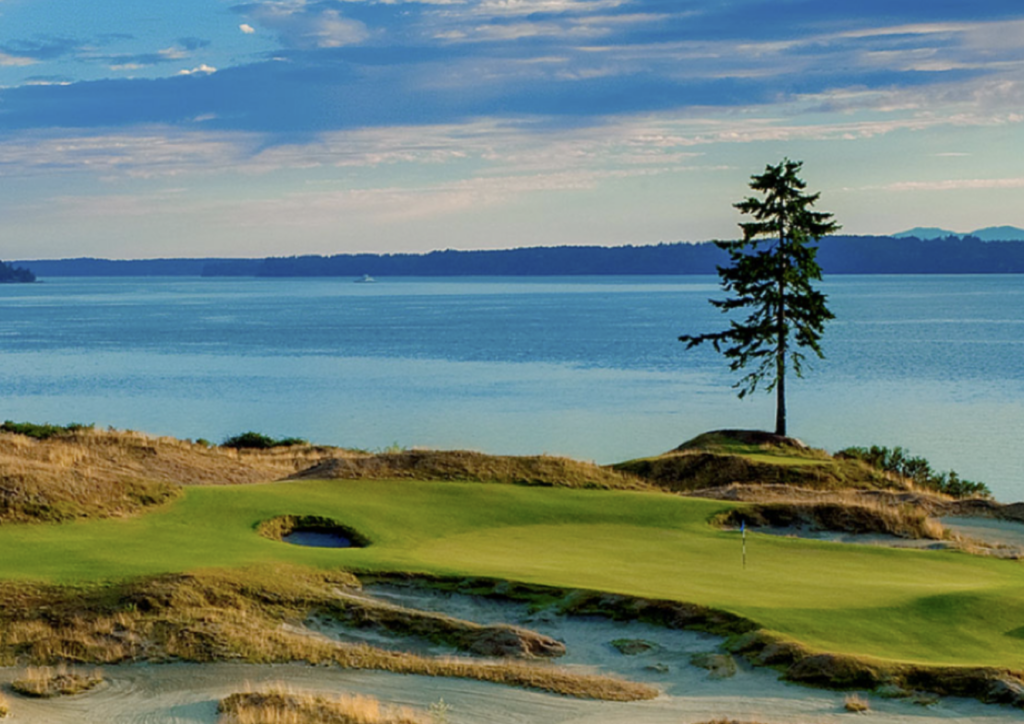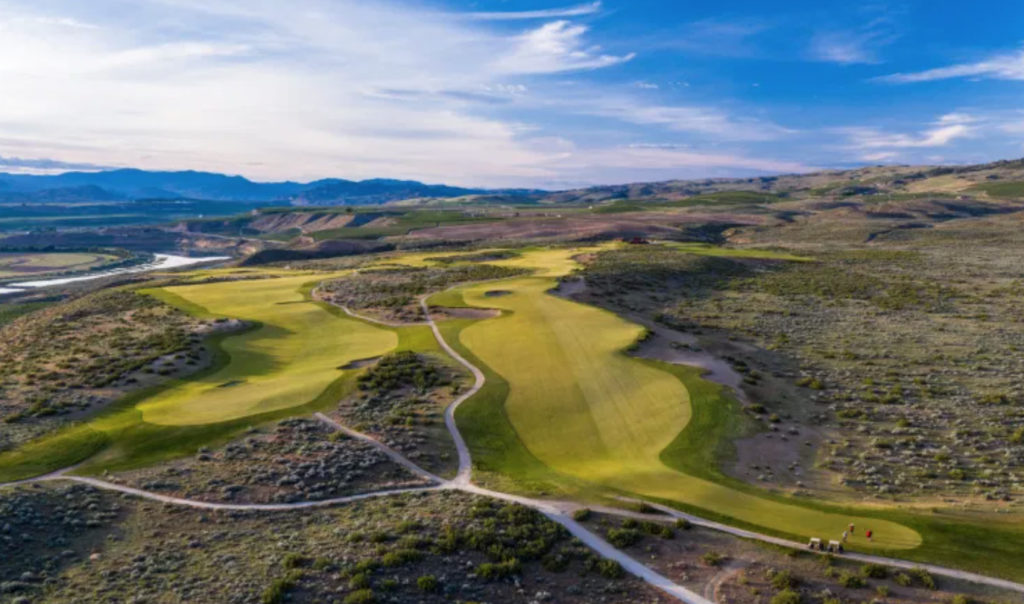
Gamble Sands
You can golf in a different climate and on a different style of course just about every day of the week in the state of Washington, with seaside links, parkland jewels and even mountainous routings tempting players who love a variety of conditions.
Washington is famous for its gorgeous views and breathtaking backdrops and there’s perhaps no better way to enjoy them than on a golf course.
Western Washington along the Pacific Ocean is known for its mild climate, considerable fog, frequent cloud cover, long-lasting drizzles in the winter and warm, temperate summers. Playing golf there is dependent on the weather, of course, and the courses are verdant and lush and many are tree lined and hilly.
The eastern region of the state, especially east of the Cascade Mountains, is more arid and can occasionally experience extreme climate.
We chose to profile three of Washington state’s best links-style public courses taken in a clockwise manner – Chambers Bay near Tacoma, Gamble Sands in Brewster in the north-central part of the state, and Palouse Ridge in the eastern college border town of Pullman.
Each gives its own flavor on the Washington golf experience and are musts on your golf bucket list. Just plan on renting a car and being awed by the sites and experiences along the way.
Chambers Bay is one of the finest links courses in the U.S.
If you are a golfer, you know about Chambers Bay from its role as host of the 2010 United States Amateur (won by Peter Uihlein) and the 2015 U.S. Open, which was taken by Jordan Spieth on the final hole.
Set along the shores of Puget Sound about an hour from Seattle, Chambers Bay is routed in the footprint of an old quarry and on land that runs toward the water from the town of University Ridge. The course was designed by Robert Trent Jones Jr. and associates Bruce Charlton and Jay Blasi and opened in 2007, playing to more than 7,900 yards from its back set of five tees.
Chambers Bay sits down in a giant bowl bordered by the railroad and one of the true links courses in the United States. The course features no interior water hazards, has just a single tree on the routing, and has expansive fairways (there is virtually no place to lose a ball) that sprawl around the huge sand dunes and bunkering systems.
The large, mounded greens complement the course’s firm and fast conditions and promote attacking the putting surfaces along the ground, which is a rarity for courses in America. Chambers Bay’s dunes accentuated with native fescue grass lining the fairways. Being that exposed, the wind is also an ever-present challenge and – be forewarned – the course allows walking only and has no loop through the park.
The back nine at Chambers Bay, especially holes 13 through 17, present some of the most memorable challenges anywhere in the game. The course’s signature hole is the 246-yard par-3 15th, which sports the only tree on the property behind the large green and next to the 16th tee. There is a large bunker complex in the foreground and the glistening Sound at the rear.
There’s no better place to play links golf in the nation, and a round here will take away your breath – and not just from the walk.

Chambers Bay
Gamble Sands is a friendly McLay Kidd gem
When Scot expatriate David McLay Kidd garnered the commission to design Gamble Sands, the Gebbers family, known for having one of the largest apple and cherry productions in the country, told him if he failed it wouldn’t be because of the land he was given.
The site had 700 acres of pure sand, so much so that when McLay Kidd drilled down 30 feet to see how deep the sand was, all that was found was more sand, huge mounds created by ancient glaciers that left deposits at the big bend of the Columbia River.
McLay Kidd’s routing, which is about four hours east-northeast of Tacoma, opened in 2014 and immediately was hailed as one of the best courses in Washington, so much so that it was named the Best New Course by Golf Digest.
There are 110 acres of fescue turf on the course, which plays at 7,305 yards from the back set of five tees. The lies here are tight and there is no traffic noise, no trees, and no water features like lakes, falls or island greens. Just pure golf like it was played centuries ago.
Gamble Sands sits atop a sprawling, treeless plateau, and sports fairways that are more than generous. There are speed slots and mounds that provide friendly bounces so balls are able to be found even if they soar into the sage and wild-plant rough. The distance from a green to the next tee is minimal on most holes, and the course has been designed primarily for walking as there are no cart paths.
The course is downright fun to play and there are some that consider Gamble Sands too easy. We say there’s no such thing as “too easy” but the course does earn its reputation as an impressive non-coastal links-style experience that allows high handicappers to really enjoy themselves. Links course aficionados will notice that the putting surfaces are a bit tame with much less undulation than other such courses, but that’s fine with us as well.
The front nine is the better of the two sides with incredible variety and some stellar views of the Columbia River, particularly on the downhill drivable 301-yard par-4 second hole.
There is plenty of challenge for the person that hits crooked off the tee in spots but mostly the course is a blast, and a welcome respite from the demands of the round at Chambers Bay.

Gamble Sands
Palouse Ridge is one of the nation’s best college courses
The official name here is Palouse Ridge Golf Club at Washington State University, and the distinction is important because the course has been rated as one of the best on-campus tracks in the nation. The late John Harbottle III fashioned this 7,308-yard gem on the bones of an old, nine-hole course and took advantage of its vast rolling property to produce an undulated links design that is a ton of fun to play.
Palouse Ridge’s fescue lined fairways blend perfectly with the surrounding farm ground that can be seen for miles from the highest points of the course. The layout, patterned after the classic courses of Scotland and opened in 2008, takes players on a trip over and through “the Palouse,” and series of undulating dunes that are the legacy of the most recent Ice Age.
The grand scale assures that nothing is ever forced and that the course fits its endless sky setting like a glove.
At Palouse Ridge, trees are the exception and not the rule, as you really don’t see many until you hit the ninth and 18th fairways. Because of the course’s exposed terrain, breezy conditions are the norm.
A unique element of Palouse Ridge is its configurations of par-5s; there are five of them on the course. Four of the final 10 holes here are three-shotters including back-to-back par 5s at holes nine and 10 and 17 and 18.
One of those par-5s is the course’s signature hole – the 626-yard 10th. The hole boasts expansive views across the property with a tee shot that plays downhill to a fairway with a pair of bunkers up the right side. Beyond those hazards, the hole moves to the right and continues traveling to a putting surface that features a long bunker on the right and an infinity edge at the back.
Two other noteworthy holes are the opener, a 463-yard par-4, and the 190-yard par-3 fourth.
On the former, take aim from the tee at the Bryan Clock Tower found in the distance on Washington State’s campus for a shot that tumbles down to an undulating fairway. From the landing area, the hole climbs to a green site that sports a lone bunker on the left and trees on the right.
The fourth melds into the hillside and plays uphill to a putting surface that’s twice as deep as it is wide, with a bunker to the right that’s closer to the rear.
Sound strategy and clever tactics are required to score at Palouse Ridge, which has become a favorite destination for those in the far eastern edge of the state and is a preferred venue for state and university tournaments. You will love it, too.

Palouse Ridge

